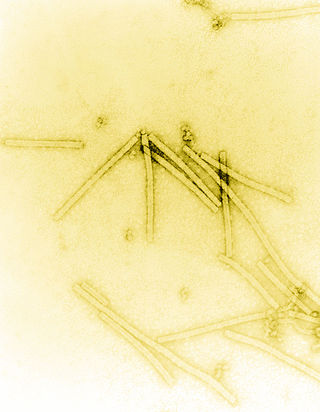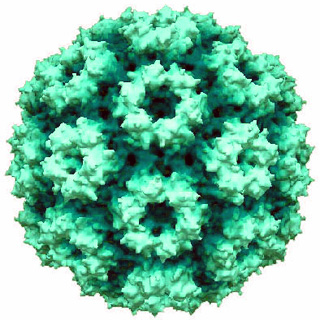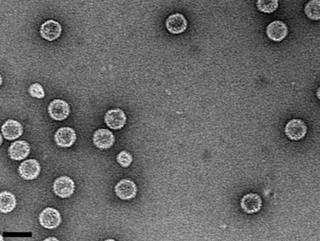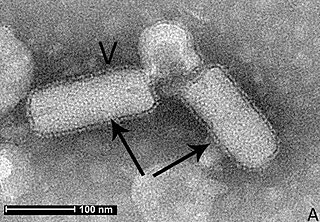
Tobacco mosaic virus (TMV) is a positive-sense single-stranded RNA virus species in the genus Tobamovirus that infects a wide range of plants, especially tobacco and other members of the family Solanaceae. The infection causes characteristic patterns, such as "mosaic"-like mottling and discoloration on the leaves. TMV was the first virus to be discovered. Although it was known from the late 19th century that a non-bacterial infectious disease was damaging tobacco crops, it was not until 1930 that the infectious agent was determined to be a virus. It is the first pathogen identified as a virus. The virus was crystallised by Wendell Meredith Stanley.
Pseudoviridae is a family of viruses, which includes three genera.
Caulimoviridae is a family of viruses infecting plants. There are 94 species in this family, assigned to 11 genera. Viruses belonging to the family Caulimoviridae are termed double-stranded DNA (dsDNA) reverse-transcribing viruses i.e. viruses that contain a reverse transcription stage in their replication cycle. This family contains all plant viruses with a dsDNA genome that have a reverse transcribing phase in their lifecycle.

Barnaviridae is a family of non-enveloped, positive-strand RNA viruses. Cultivated mushrooms serve as natural hosts. The family has one genus, Barnavirus, which contains one species: Mushroom bacilliform virus. Diseases associated with this family includes La France disease.
Ribosome shunting is a mechanism of translation initiation in which ribosomes bypass, or "shunt over", parts of the 5' untranslated region to reach the start codon. However, a benefit of ribosomal shunting is that it can translate backwards allowing more information to be stored than usual in an mRNA molecule. Some viral RNAs have been shown to use ribosome shunting as a more efficient form of translation during certain stages of viral life cycle or when translation initiation factors are scarce. Some viruses known to use this mechanism include adenovirus, Sendai virus, human papillomavirus, duck hepatitis B pararetrovirus, rice tungro bacilliform viruses, and cauliflower mosaic virus. In these viruses the ribosome is directly translocated from the upstream initiation complex to the start codon (AUG) without the need to unwind RNA secondary structures.

Cowpea chlorotic mottle virus, known by the abbreviation CCMV, is a virus that specifically infects the cowpea plant, or black-eyed pea. The leaves of infected plants develop yellow spots, hence the name "chlorotic". Similar to its "brother" virus, Cowpea mosaic virus (CPMV), CCMV is produced in high yield in plants. In the natural host, viral particles can be produced at 1–2 mg per gram of infected leaf tissue. Belonging to the bromovirus genus, cowpea chlorotic mottle virus (CCMV) is a small spherical plant virus. Other members of this genus include the brome mosaic virus (BMV) and the broad bean mottle virus (BBMV).
Petuvirus is a genus of viruses, in the family Caulimoviridae order Ortervirales. Plants serve as natural hosts. There is only one species in this genus: Petunia vein clearing virus. Diseases associated with this genus include: plants: chlorotic vein clearing, leaf malformation.
Rice hoja blanca tenuivirus (RHBV), Spanish for "white leaf rice virus", is a plant virus in the family Phenuiviridae. RHBV causes Hoja blanca disease (HBD), which affects the leaves of the rice plant Oryza sativa, stunting the growth of the plant or killing it altogether. RHBV is carried by an insect vector, Tagosodes orizicolus, a type of planthopper. The virus is found in South America, Mexico, throughout Central America, the Caribbean region, and the southern United States. In South America, the disease is endemic to Colombia, Venezuela, Ecuador, Peru, Suriname, French Guiana and Guyana.

Cacao swollen shoot virus (CSSV) is a plant pathogenic virus of the family Caulimoviridae that primarily infects cacao trees. It decreases cacao yield within the first year of infection, and usually kills the tree within a few years. Symptoms vary by strain, but leaf discoloration, stem/root swelling, and die-back generally occur. The virus is transmitted from tree to tree by mealybug vectors. It was first discovered in Ghana in 1936, and is currently endemic in Togo, Ghana and Nigeria. Over 200 million trees have already been claimed by this disease, which has prompted Ghana to launch the most ambitious and costly eradication effort of any country in the world against a viral plant disease.
Panicum mosaic virus (PMV) is a positive-sense single-stranded RNA viral pathogen that infects plant species in the panicoid tribe of the grass family, Poaceae. The pathogen was first identified in Kansas in 1953 and most commonly causes disease on select cultivars of turf grass, switchgrass, and millet. The disease most commonly associated with the panicum mosaic virus pathogen is St. Augustine Decline Syndrome, which infects species of turf grass and causes chlorotic mottling. In addition to St. Augustine Decline, panicum mosaic virus is responsible for chlorotic streaking and mild green mosaicking in select cultivars of switchgrass and millet.

Benyvirus is a genus of viruses, in the family Benyviridae. Plants serve as natural hosts. There are four species in this genus. Diseases associated with this genus include: BNYVV: rhizomania.

Phytoreovirus is a genus of viruses, in the family Reoviridae, in the subfamily Sedoreovirinae. They are non-turreted reoviruses that are major agricultural pathogens, particularly in Asia. Oryza sativa for RDV and RGDV, dicotyledonous for WTV, and leafhoppers serve as natural hosts. There are three species in this genus. Diseases associated with this genus include: WTV: galls (tumor). RDV: dwarf disease of rice. RGDV: dwarfing, stunting, and galls.

Picobirnavirus is a genus of double-stranded RNA viruses. It is the only genus in the family Picobirnaviridae. Although amniotes, especially mammals, were thought to serve as hosts, it has been recently suggested that these viruses might infect bacteria and possibly some other invertebrates. If they do infect bacteria, then they are Bacteriophages. There are three species in this genus. Associated symptoms include gastroenteritis in animals and humans, though the disease association is unclear.

Badnavirus is a genus of viruses, in the family Caulimoviridae order Ortervirales. Plants serve as natural hosts. There are 67 species in this genus. Diseases associated with this genus include: CSSV: leaf chlorosis, root necrosis, red vein banding in young leaves, small mottled pods, and stem/root swelling followed by die-back. Infection decreases yield by 25% within one year, 50% within two years and usually kills trees within 3–4 years.

Caulimovirus is a genus of viruses, in the family Caulimoviridae order Ortervirales. They are para-retroviruses with dsDNA and plants as their host. There are 12 species in this genus. Diseases associated with this genus include: vein-clearing or banding mosaic.

Cytorhabdovirus is a genus of viruses in the family Rhabdoviridae, order Mononegavirales. Plants serve as natural hosts.
Polerovirus is a genus of viruses, in the family Solemoviridae. Plants serve as natural hosts. There are 26 species in this genus. Diseases associated with this genus include: PLRV causes prominent rolling of the leaves of potato and a stiff upright habit of the plants; necrosis of the phloem and accumulation of carbohydrates in the leaves.
Waikavirus is a genus of viruses in the order Picornavirales, in the family Secoviridae. Plants, poaceae, cyperaceae, and gramineae serve as natural hosts. There are four species in this genus. Diseases associated with this genus include: MCDV: plant stunting and chlorotic striping of tertiary leaf veins in maize.
Zeavirus is a genus of viruses, in the family Tombusviridae. Monocots plants serve as natural hosts. There is only one species in this genus: Maize necrotic streak virus.
Oryza officinalis is species of flowering plant in the genus Oryza (rice) native to India, Nepal, the eastern Himalaya, southeast Asia, south-central and southeast China, Hainan, the Philippines, New Guinea, and the Northern Territory and Queensland in Australia. A perennial diploid with the CC rice genome, it can reach 3 m (10 ft) in height. It is the namesake of a widespread species complex.








